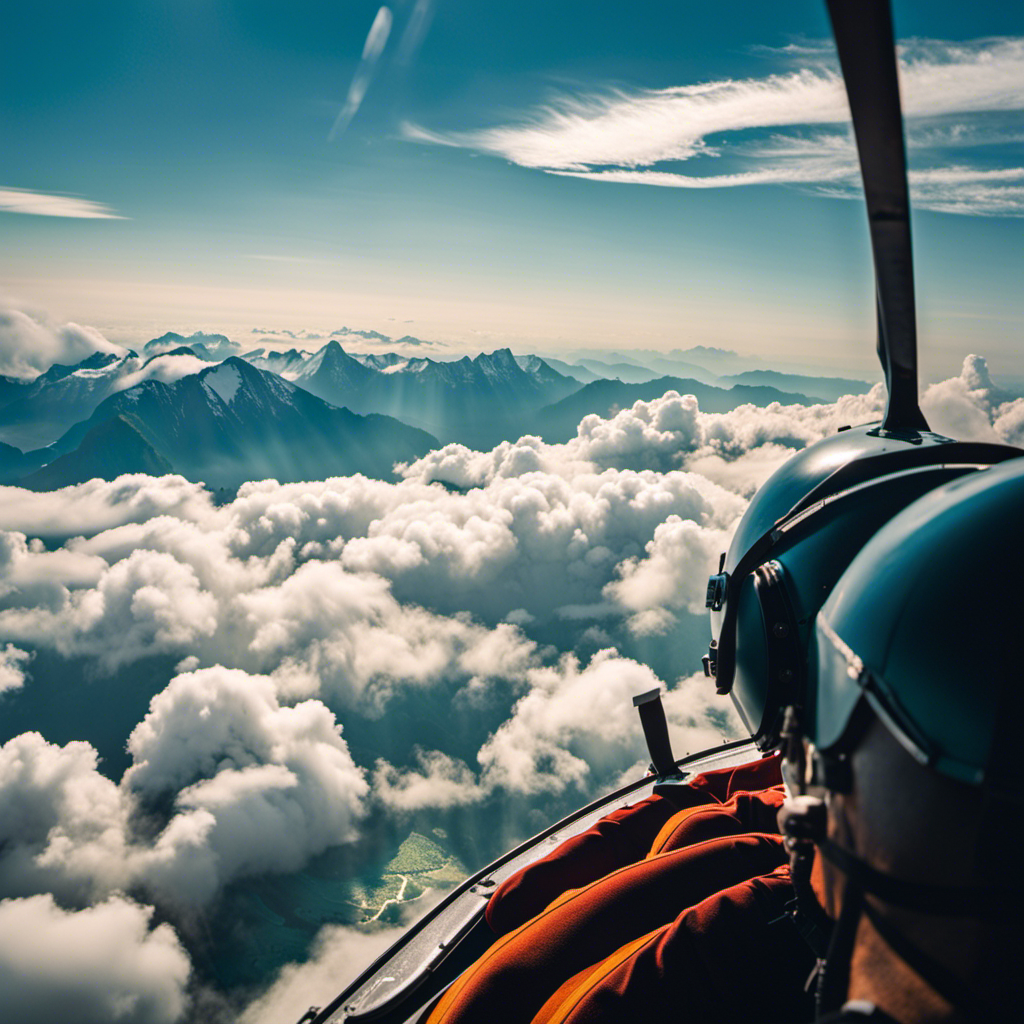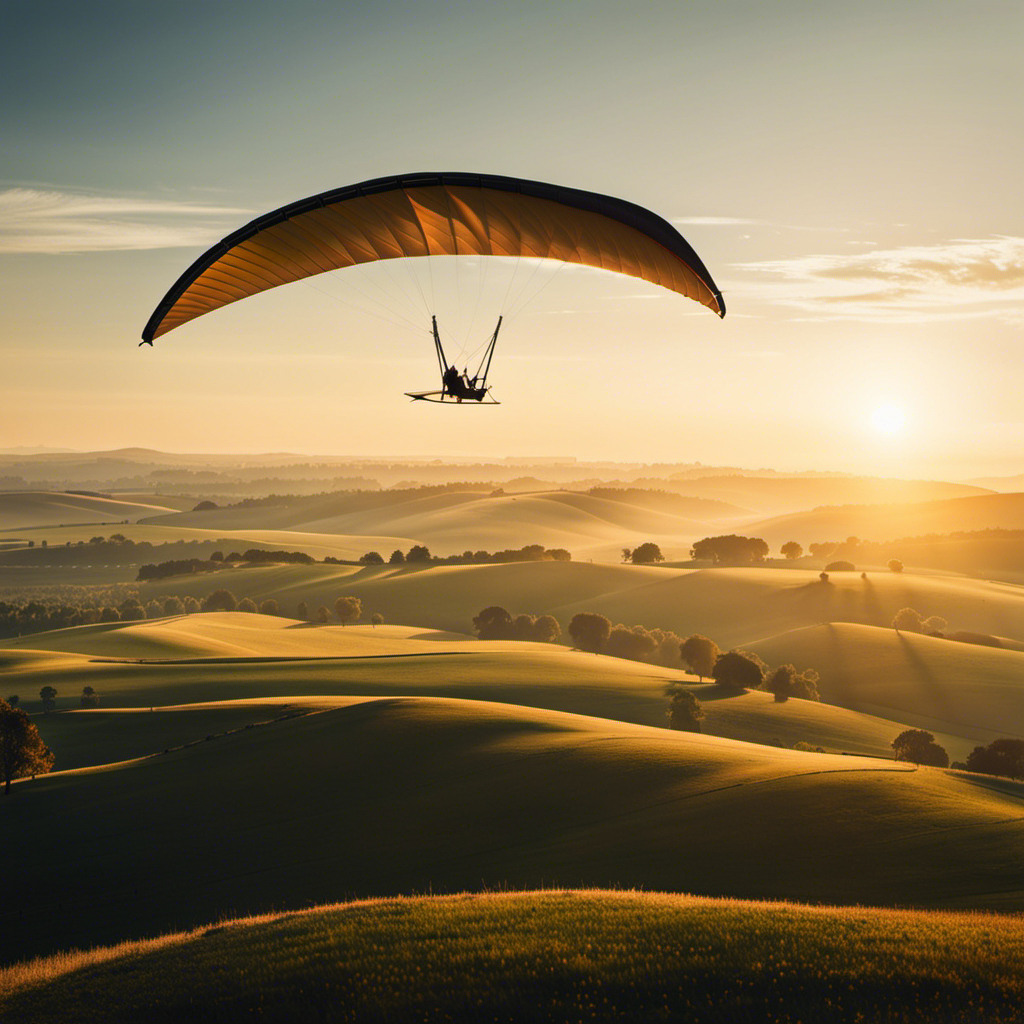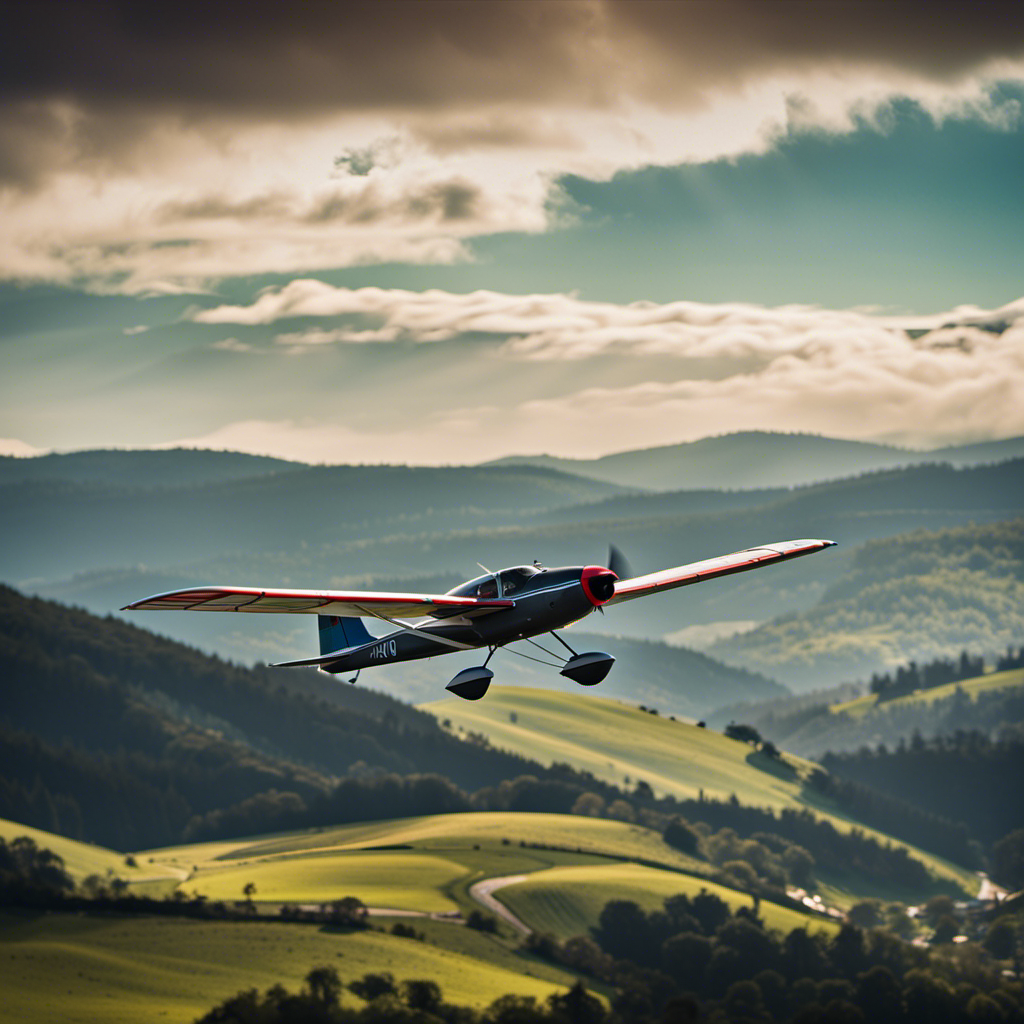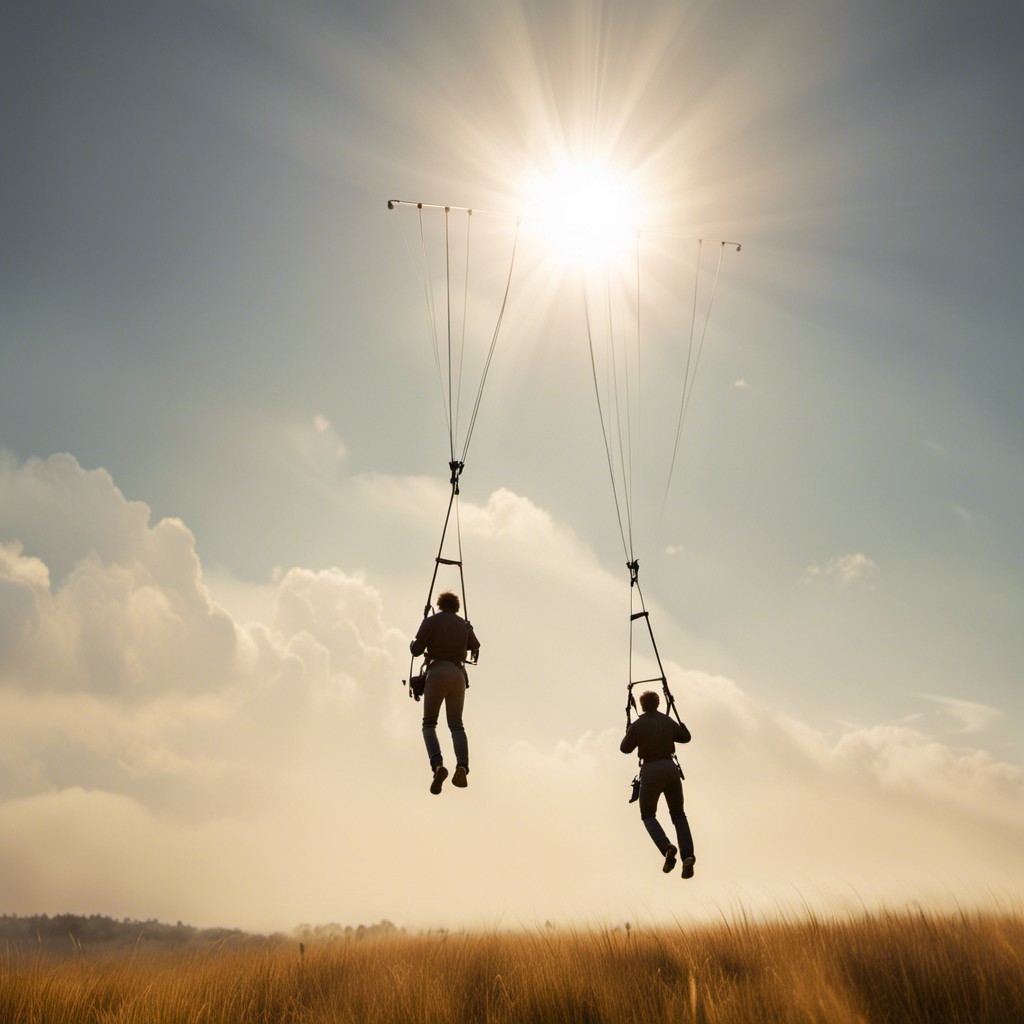Flying through the sky, I have always felt an incredible sense of freedom and excitement. If you also dream of flying a glider, let me guide you through the necessary steps to make this dream come true.
From understanding the basics of glider flight to obtaining the necessary certifications, this article will provide you with the essential steps to take.
Get ready to embark on an adventure that will take you skyward bound.
Key Takeaways
- Submitting complete and accurate documentation is crucial for a smooth license application process.
- Regular flying is essential for building flight experience and improving glider handling skills.
- Advanced training and certifications, such as CPL, IR, and FIR, can expand knowledge and opportunities as a glider pilot.
- Staying current and engaged in continuous education is important for staying up-to-date with gliding techniques and safety procedures.
Understand the Basics of Glider Flight
Before you begin training as a glider pilot, it’s important to understand the basics of glider flight.
Gliders, also known as sailplanes, are aircraft that do not have an engine and rely on the natural forces of flight to stay airborne. They are designed to glide through the air by using the lift generated by the shape of their wings.
Glider pilots control the aircraft using the ailerons, elevators, and rudder to maneuver and maintain control. They also need to be familiar with the principles of aerodynamics, such as lift, drag, and gravity.
Understanding these basics is essential for safe and successful glider flying.
Now let’s move on to the next requirement: meeting the minimum age and health requirements.
Meet the Minimum Age and Health Requirements
To become a glider pilot, there are certain requirements you must meet. The first requirement is age. The minimum age varies depending on the country, but generally, you need to be at least 14 or 16 years old to start training. Another requirement is good health. You need to be in good physical condition to handle the demands of glider flight. This means having normal vision and hearing, as well as being free from any medical conditions that could impair your ability to fly safely. It’s important to consult with a medical professional before starting your training to ensure you meet these requirements. Once you meet the age and health criteria, you can move on to the next step of obtaining a student pilot certificate. This certificate will allow you to begin your training officially.
Obtain a Student Pilot Certificate
Once you’ve met the age and health requirements, you’ll need to obtain a student pilot certificate in order to officially begin your glider training. This certificate serves as proof that you have met the necessary qualifications and are eligible to learn how to fly a glider.
To obtain a student pilot certificate, you will need to complete an application through the Federal Aviation Administration (FAA) and pass a medical examination. Here are a couple of things to keep in mind during this process:
- Make sure to gather all the required documents, such as identification and proof of age.
- Schedule your medical examination with an FAA-approved aviation medical examiner.
Once you have your student pilot certificate in hand, you will be ready to move on to the next step, which is completing ground school training.
Complete Ground School Training
During ground school training, you’ll learn the essential knowledge and skills necessary to become a confident and knowledgeable pilot. This training is a crucial step in your journey to becoming a glider pilot, as it covers a wide range of topics related to aviation and flying. In ground school, you’ll study subjects such as aerodynamics, meteorology, navigation, aircraft systems, and regulations. These classes provide a solid foundation and understanding of the principles and concepts that form the backbone of safe and successful flying. To give you an idea of what you can expect to learn, here’s a table that outlines some of the key topics covered in ground school:
| Topics | Description | Importance |
|---|---|---|
| Aerodynamics | Study of forces and motion in flight | Understanding flight principles |
| Meteorology | Analysis of weather patterns and phenomena | Assessing weather conditions for safe flying |
| Navigation | Techniques for determining position | Navigating to desired destinations |
| Aircraft Systems | Understanding the components of an aircraft | Ensuring proper operation of the glider |
Once you have completed ground school training, the next step is to log flight hours with an instructor.
Log Flight Hours with an Instructor
You’ll start logging flight hours with an instructor to gain practical flying experience and refine your skills. This is a crucial step in becoming a glider pilot. Here are some important aspects of logging flight hours with an instructor:
-
Hands-on experience: You’ll have the opportunity to take control of the glider and practice various maneuvers under the guidance of an experienced instructor.
-
Skill development: Through regular practice, you’ll develop essential skills such as takeoffs, landings, turning, and soaring techniques.
-
Safety training: Your instructor will teach you important safety protocols and emergency procedures to ensure a safe flying experience.
-
Decision-making practice: You’ll learn how to make informed decisions while flying, considering factors like weather conditions and airspace regulations.
By logging flight hours with an instructor, you’ll gain the practical knowledge and experience necessary to progress towards becoming a certified glider pilot.
Once you’ve mastered this step, you’ll be ready to move on to the next challenge: passing the written and practical exams.
Pass the Written and Practical Exams
To become a certified glider pilot, it’s important to successfully pass both the written and practical exams. These exams are designed to assess your knowledge and skills in various aspects of glider flying.
The written exam covers topics such as aerodynamics, weather, navigation, regulations, and emergency procedures. It tests your understanding of the theoretical concepts that are essential for safe and proficient glider operations.
On the other hand, the practical exam evaluates your ability to apply this knowledge in real-life flying situations. It includes tasks like pre-flight inspections, takeoffs and landings, maneuvering, emergency procedures, and navigation.
Successfully passing these exams demonstrates your competence and readiness to fly gliders. Once you have completed the exams, you can apply for a glider pilot license, taking the next step towards your dream of soaring through the skies.
Apply for a Glider Pilot License
Once you’ve passed the written and practical exams, you can apply for a glider pilot license. This is an exciting step towards becoming a certified glider pilot.
To apply for the license, you will need to submit the necessary documentation to the aviation authority in your country. This typically includes proof of your age, medical fitness, and completion of the required training hours. Additionally, you may need to provide evidence of your theoretical knowledge and practical skills.
It’s important to carefully review the application requirements and ensure that you have all the necessary documents before submitting your application. Once your license is approved, you can continue building flight experience and further hone your skills as a glider pilot.
Continue Building Flight Experience
As I gain more flight experience, I’ll become more confident in my skills as a glider pilot. Building flight experience is crucial for any aspiring pilot. Here are three key ways to continue building this experience:
-
Fly frequently: The more time you spend in the air, the better you will become at handling the glider. Regular flying allows you to refine your skills and develop a deeper understanding of glider dynamics.
-
Explore different conditions: Flying in various weather conditions and locations will expose you to different challenges and help you become a well-rounded pilot. It’s important to experience different wind patterns, thermals, and crosswinds to enhance your decision-making abilities.
-
Seek mentorship: Learning from experienced glider pilots can greatly accelerate your growth. Mentors can provide valuable guidance, share their knowledge, and help you improve your flying skills.
Consider Advanced Training and Certifications
Seeking advanced training and certifications will expand my knowledge and skills as a glider pilot. One option for advanced training is pursuing a Commercial Pilot License (CPL) with a glider category rating. This certification will allow me to fly gliders for compensation or hire.
Additionally, I can consider obtaining an Instrument Rating (IR) for gliders, which will enable me to fly in instrument meteorological conditions. This advanced training will enhance my ability to navigate and operate gliders safely and effectively.
Furthermore, I can explore specialized certifications such as a Flight Instructor Rating (FIR) for gliders, enabling me to teach and share my passion for gliding with others. By obtaining advanced training and certifications, I will be better equipped to handle various flying scenarios and broaden my opportunities as a glider pilot.
To stay current and engage in ongoing learning and improvement, I will need to actively participate in continuous education programs and stay informed about the latest advancements in gliding techniques and safety procedures.
Stay Current and Engage in Ongoing Learning and Improvement
To stay current and continue improving, I actively participate in continuous education programs and stay informed about the latest advancements in gliding techniques and safety procedures. This not only helps me enhance my skills as a glider pilot but also ensures that I am up to date with the best practices in the industry.
Engaging in ongoing learning and improvement allows me to stay ahead of the curve and adapt to any changes or challenges that may arise. It instills a sense of confidence and competence in me, knowing that I am well-prepared for any situation.
Additionally, continuous education programs and staying informed about advancements in gliding techniques and safety procedures foster a sense of passion and dedication, driving me to constantly strive for excellence. It keeps the excitement alive and makes every flight a rewarding experience.
Continuous education programs provide me with opportunities to learn from experienced instructors and fellow pilots, fostering a sense of camaraderie and collaboration.
Staying informed about the latest advancements in gliding techniques and safety procedures allows me to always be at the forefront of innovation, ensuring the highest level of safety and efficiency in my flights.
Frequently Asked Questions
What are the key benefits of glider flight compared to other forms of aviation?
The key benefits of glider flight compared to other forms of aviation include the ability to soar silently through the sky, the cost-effectiveness of gliders, and the opportunity to develop superior flying skills.
Can someone with a fear of heights still become a glider pilot?
Yes, someone with a fear of heights can still become a glider pilot. With proper training and support, individuals can overcome their fear and focus on the exhilarating experience of glider flight.
How long does it typically take to obtain a glider pilot license?
Obtaining a glider pilot license typically takes anywhere from a few months to a year, depending on individual factors such as the frequency of training sessions and the individual’s aptitude for flying.
Are there any restrictions on where glider pilots can fly?
As a glider pilot, I must be aware of the restrictions on where I can fly. These limitations ensure safety and prevent collisions with other aircraft. It’s essential to follow airspace regulations and respect the boundaries set for our own protection.
What are the career opportunities for glider pilots?
There are various career opportunities for glider pilots, including becoming a flight instructor, working for glider clubs or schools, or participating in competitive gliding events. The demand for glider pilots is growing steadily.
Conclusion
So there you have it, folks! We’ve covered all the key requirements for aspiring glider pilots.
By understanding the basics of glider flight, meeting the age and health requirements, obtaining a student pilot certificate, completing ground school training, logging flight hours with an instructor, and applying for a glider pilot license, you’ll be well on your way to soaring the skies.
Remember to continue building flight experience, consider advanced training and certifications, and stay current with ongoing learning.
Happy flying!
With a heart that soars as high as the skies, Aria, affectionately known as “Skylark,” is the driving force behind Soaring Skyways. Her journey into the gliding world began as a young dreamer gazing up at the soaring birds, yearning to experience the weightlessness and freedom they embodied. With years of experience both in the cockpit and behind the scenes, Aria’s commitment to the gliding community is unwavering.










